1996 CHEVROLET CORVETTE check oil
[x] Cancel search: check oilPage 241 of 386
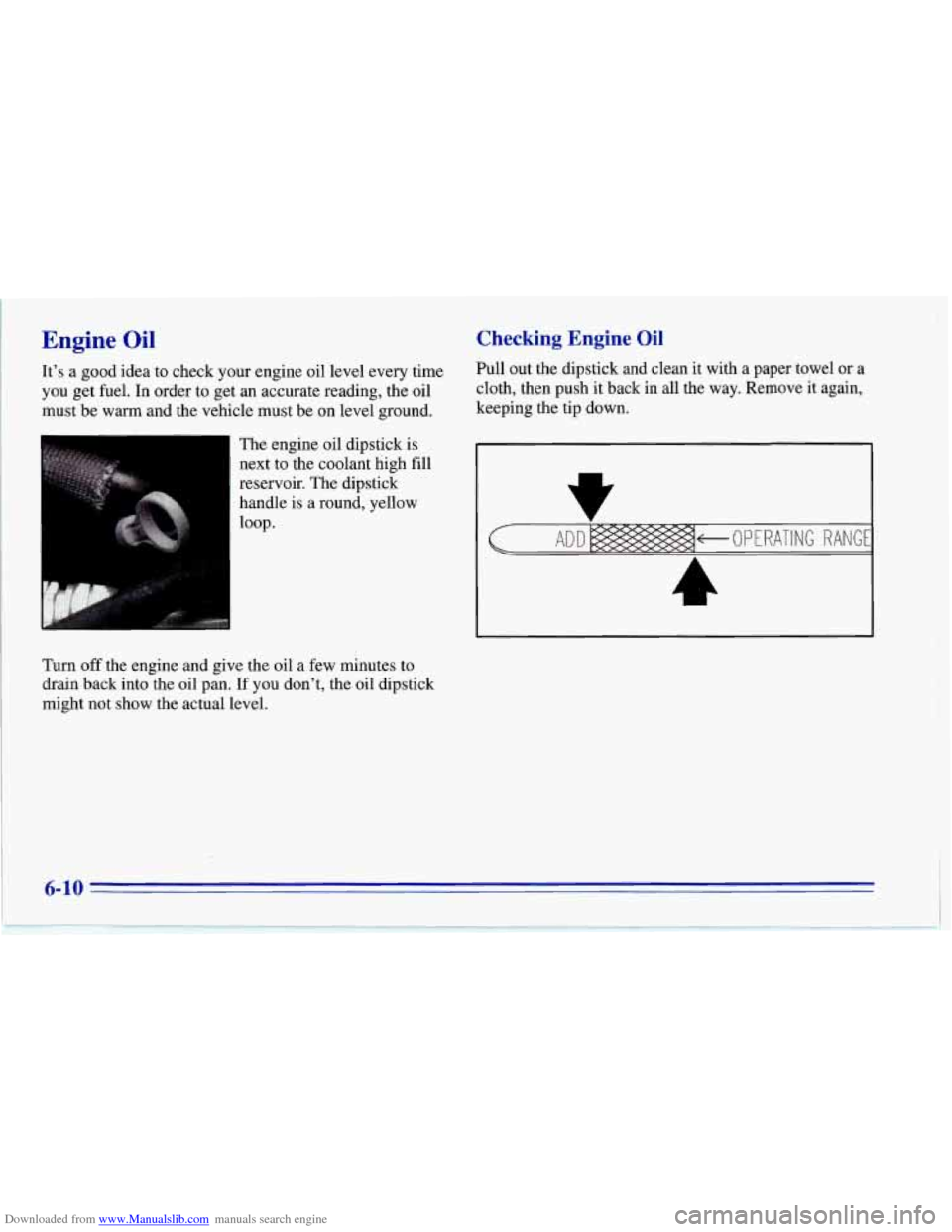
Downloaded from www.Manualslib.com manuals search engine Engine Oil
It’s a good idea to check your engine oil level every time
you get fuel. In order to get an accurate reading, the oil
must be warm and the vehicle must be on level ground.
The engine oil dipstick is
next to the coolant high fill
reservoir. The dipstick
handle is a round, yellow
loop.
Turn
off the engine and give the oil a few minutes to
drain back into the oil pan. If you don’t, the oil dipstick
might not show the actual level.
Checking Engine Oil
Pull out the dipstick and clean it with a paper towel or a
cloth, then push it back in all the way. Remove it again,
keeping the tip down.
6-10
Page 249 of 386
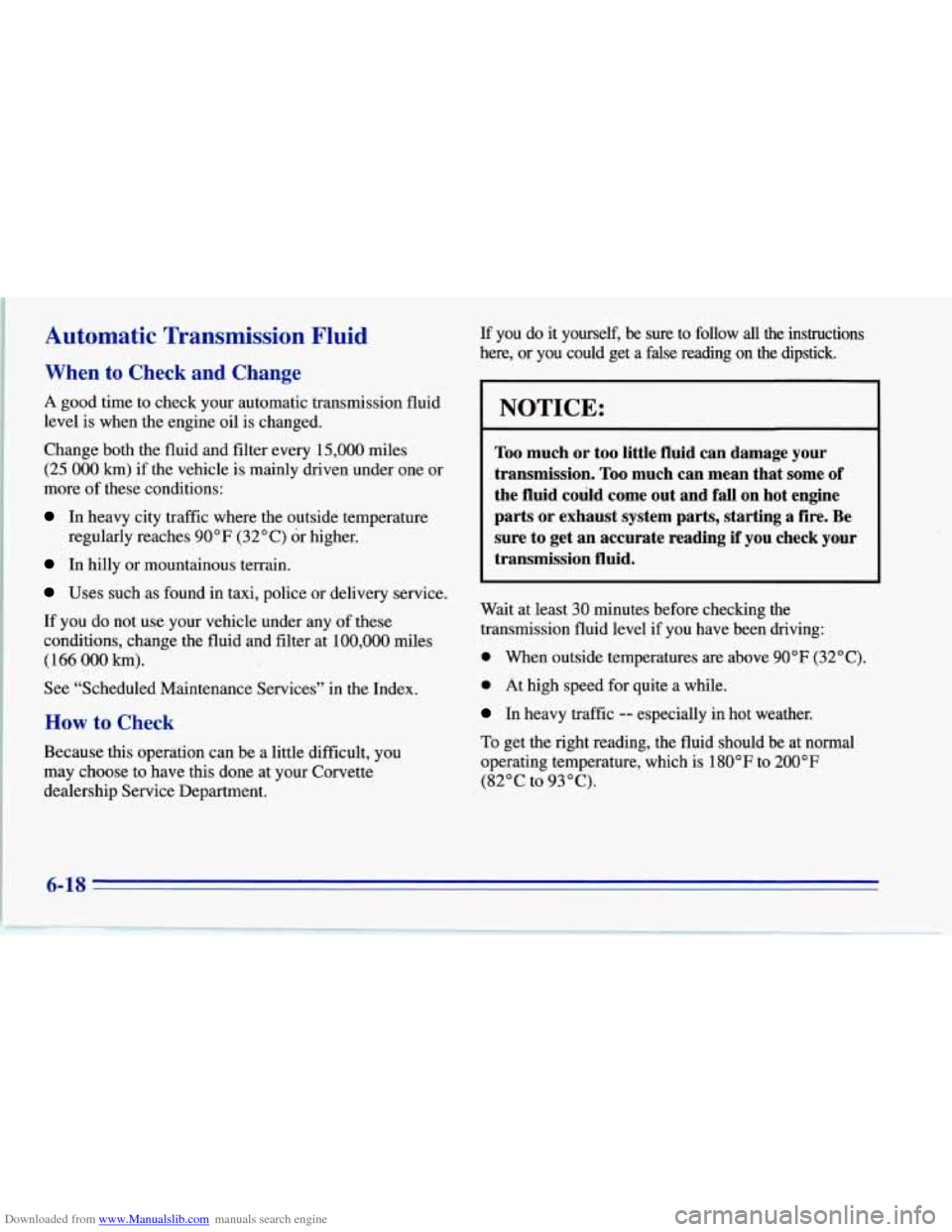
Downloaded from www.Manualslib.com manuals search engine Automatic Transmission Fluid
When to Check and Change
A good time to check your automatic transmission fluid
level is when the engine oil is changed.
Change both the fluid and filter every
15,000 miles
(25 000 km) if the vehicle is mainly driven under one or
more of these conditions:
In heavy city traffic where the outside temperature
In hilly or mountainous terrain.
Uses such as found in taxi, police or delivery service.
If you do not use your vehicle under any of these
conditions, change the fluid and filter at
100,000 miles
(166 000 km).
See “Scheduled Maintenance Services” in the Index.
How to Check
Because this operation can be a little difficult, you
may choose to have this done at your Corvette
dealership Service Department.
regularly
reaches 90
OF (32 O C) or higher.
If you do it yourself, be sure to follow all the instructions
here, or you could get
a false reading on the dipstick.
I NOTICE:
Too much or too little fluid can damage your
transmission.
Too much can mean that some of
the fluid could come out and fall on hot engine
parts or exhaust system parts, starting a fire. Be
sure to get an accurate reading if you check your
transmission fluid.
Wait at least 30 minutes before checking the
transmission fluid level if you have been driving:
0 When outside temperatures are above 90°F (32°C).
0 At high speed for quite a while.
In heavy traffic -- especially in hot weather.
To get the right reading, the fluid should be at normal
operating temperature, which is
180°F to 200°F
(82°C to 93°C).
Page 251 of 386
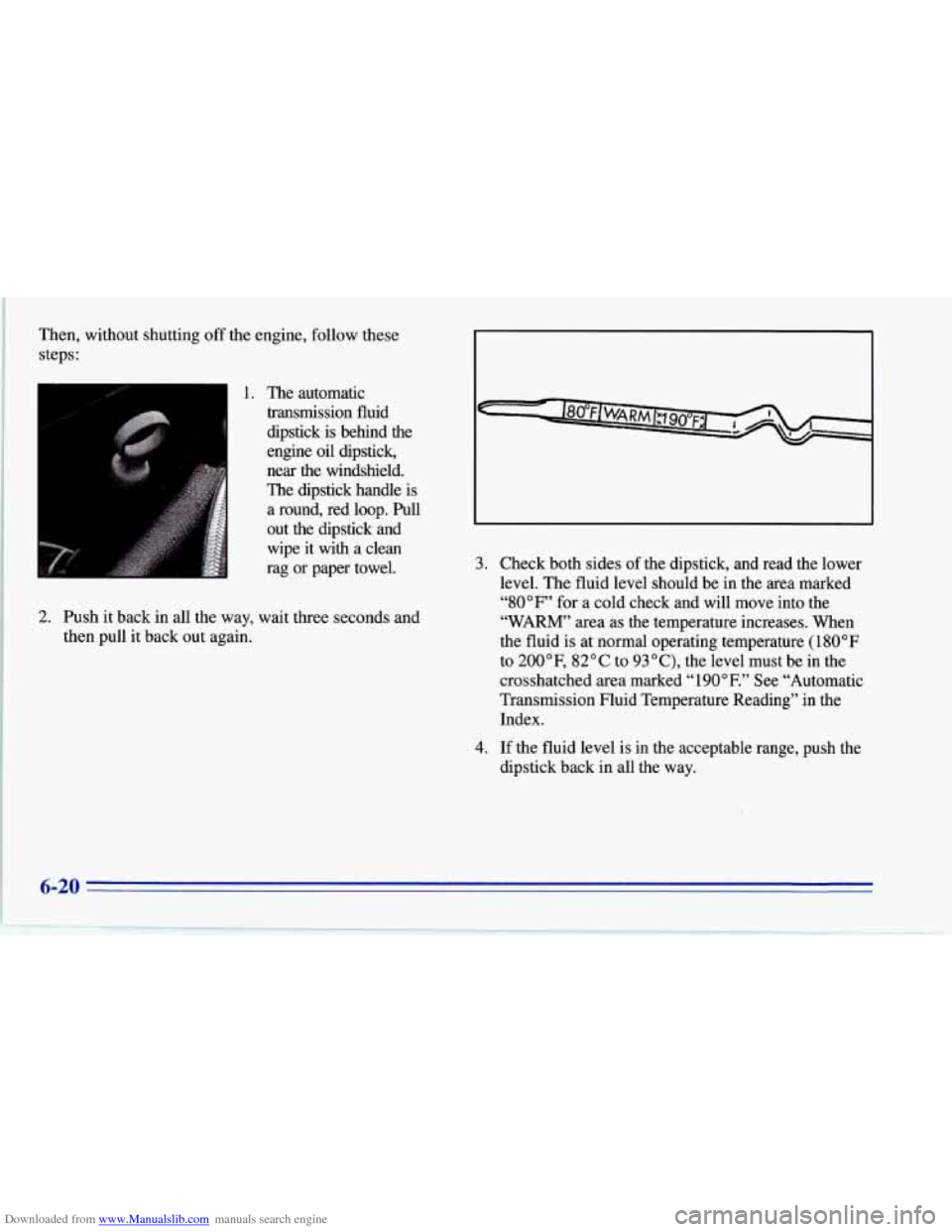
Downloaded from www.Manualslib.com manuals search engine I
Then, without shutting off the engine, follow these
steps:
1. The automatic
transmission fluid dipstick is behind the
engine oil dipstick,
ne&- the windshield.
The dipstick handle is a round, red loop.
Pull
out the dipstick and wipe it with a clean
rag or paper towel.
2. Push it back in all the way, wait three seconds and
then pull it back out again. 3.
Check both sides
of the dipstick, and read the lower
level. The fluid level should be in the area marked
“80°F” for a cold check and will move into the
“WARM” area as the temperature increases. When
the fluid
is at normal operating temperature (180°F
to 200”F, 82°C to 93”C), the level must be in the
crosshatched area marked
“ 190°F.’’ See “Automatic
Transmission Fluid Temperature Reading” in the
Index.
4. If the fluid level is in the acceptable range, push the
dipstick back in all the way.
6-20
Page 252 of 386
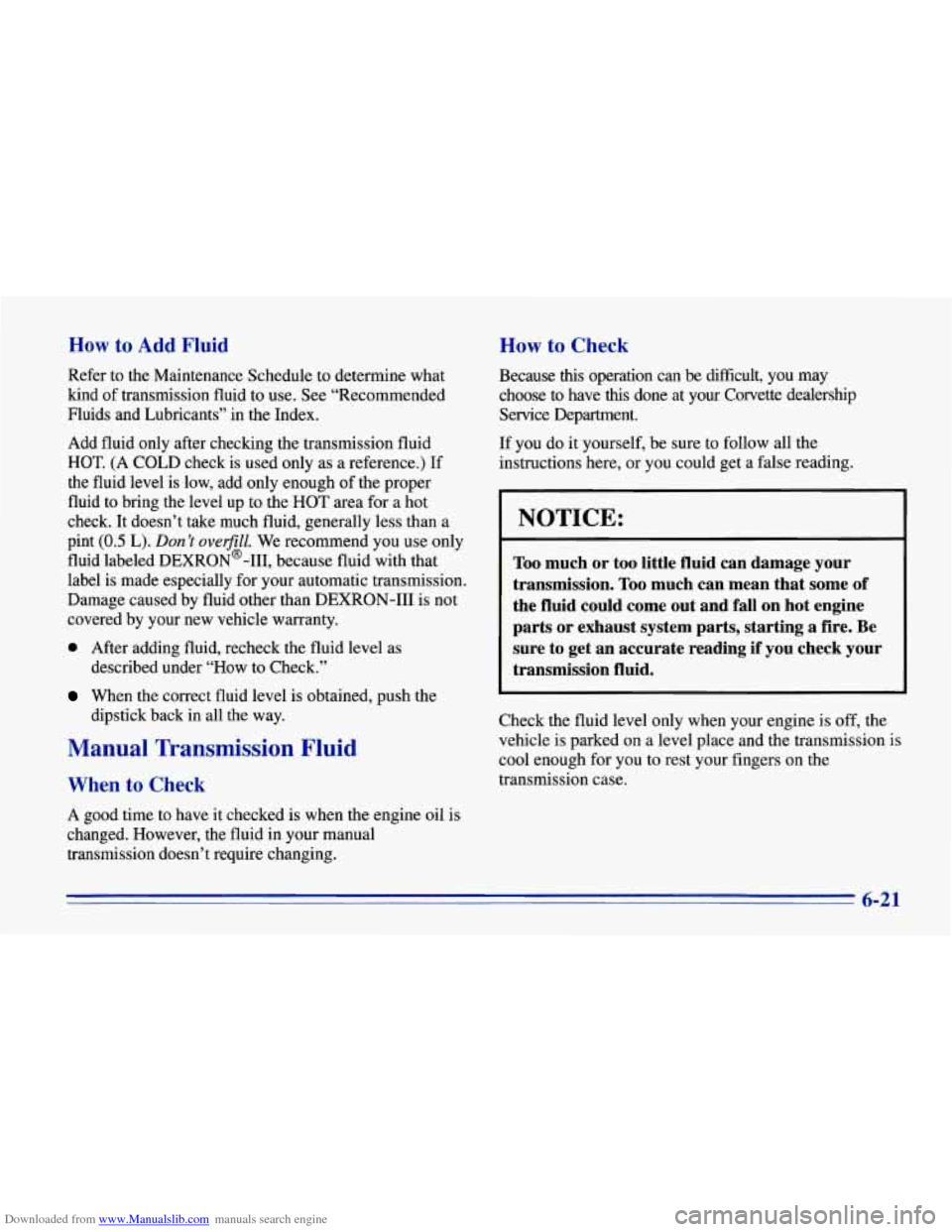
Downloaded from www.Manualslib.com manuals search engine How to Add Fluid
Refer to the Maintenance Schedule to determine what
kind of transmission fluid to use. See “Recommended
Fluids and Lubricants” in the Index.
Add fluid only after checking the transmission fluid
HOT.
(A COLD check is used only as a reference.) If
the fluid level is low, add only enough of the proper
fluid to bring the level up to the
HOT area for a hot
check. It doesn’t take much fluid, generally less than a
pint
(0.5 L). Don’t overfill. We recommend you use only
fluid labeled DEXRON@-111, because fluid with that
label is made especially for your automatic transmission.
Damage caused by fluid other than DEXRON-I11 is not
covered by your new vehicle warranty.
0 After adding fluid, recheck the fluid level as
described under “How to Check.”
When the correct fluid level is obtained, push the
dipstick back in all the way.
Manual Transmission Fluid
When to Check
A good time to have it checked is when the engine oil is
changed. However, the fluid in your manual
transmission doesn’t require changing.
How to Check
Because this operation can be difficult, you may
choose to have
this done at your Corvette dealership
Service Department.
If you do it yourself, be sure to follow all the
instructions here, or you could get a false reading.
NOTICE:
Too much or too little fluid can damage your
transmission.
Too much can mean that some of
the fluid could come out and fall on hot engine
parts or exhaust system parts, starting a fire. Be
sure to get an accurate reading
if you check your
transmission fluid.
Check the fluid level only when your engine is off, the
vehicle is parked on a level place and the transmission
is
cool enough for you to rest your fingers on the
transmission case.
6-21
Page 257 of 386

Downloaded from www.Manualslib.com manuals search engine What to Use
Use a mixture of one-half clean water (preferably
distilled) and one-half
DEX-COOL TM (orange-colored,
silicate-free) antifreeze that meets GM Specification
6277M, which won’t damage aluminum parts. Use
GM Engine Coolant Supplement (sealer) (GM
Part
No. 3634621) with any complete coolant change. If you
use this mixture, you don’t need to add anything else.
Adding only plain water to your cooling system
can be dangerous. Plain
water, or some other
liquid like alcohol, can boil before the proper
coolant mix will. Your vehicle’s coolant warning
system is set for the proper coolant mix. With
plain water or the wrong mix, your engine could
get too hot but you wouldn’t get the overheat
warning. Your engine could catch fire and
you or
others could be burned. Use
a 50/50 mix of clean
water and
DEX-COOL TM (orange-colored.
silicate-free) antifreeze.
NOTICE:
If you use an improper coolant mix, your engine
could overheat and be badly damaged. The
repair cost wouldn’t be covered by your
warranty. Too much water in the
mix can freeze
and crack the engine, radiator, heater core and
other parts.
If you have to add coolant more than four times a year,
have your dealer check your cooling system.
NOTICE:
If you use the proper coolant, you don’t have to
add extra inhibitors or additives which claim to
improve the system. These can be harmful.
.
Page 264 of 386

Downloaded from www.Manualslib.com manuals search engine Checking Brake Fluid
You can check the brake fluid without taking off the cap.
Just look at the brake fluid reservoir. The fluid level
should be above the MIN mark on the reservoir. If it
isn’t, have your brake system checked to see if there
is a
leak.
After work is done
on the brake hydraulic system, make
sure the level is between the MIN and MAX marks.
What to Add
When you
do need brake fluid, use only DOT-3 brake
fluid
-- such as Delco Supreme 11 @ (GM Part
No. 1052535). Use new brake fluid from a sealed
container
only, and always clean the brake fluid
reservoir cap before removing it.
1
With the wrong kind of fluid in your brake
system, your brakes may not work well, or they
may not even work
at all. This could cause a
crash. Always use the proper brake fluid.
NOTICE:
0 Using the wrong fluid can badly damage
brake system parts. For example, just
a few
drops
of mineral-based oil, such as engine
oil, in your brake system can damage brake
system parts
so badly that they’ll have to be
replaced. Don’t let someone put in the
wrong kind of fluid.
If you spill brake fluid on your vehicle’s
painted surfaces, the paint finish can be
damaged. Be careful not to spill brake fluid
on your vehicle.
If you do, wash it off
immediately. See “Appearance Care” in the
Index.
6-33
Page 351 of 386
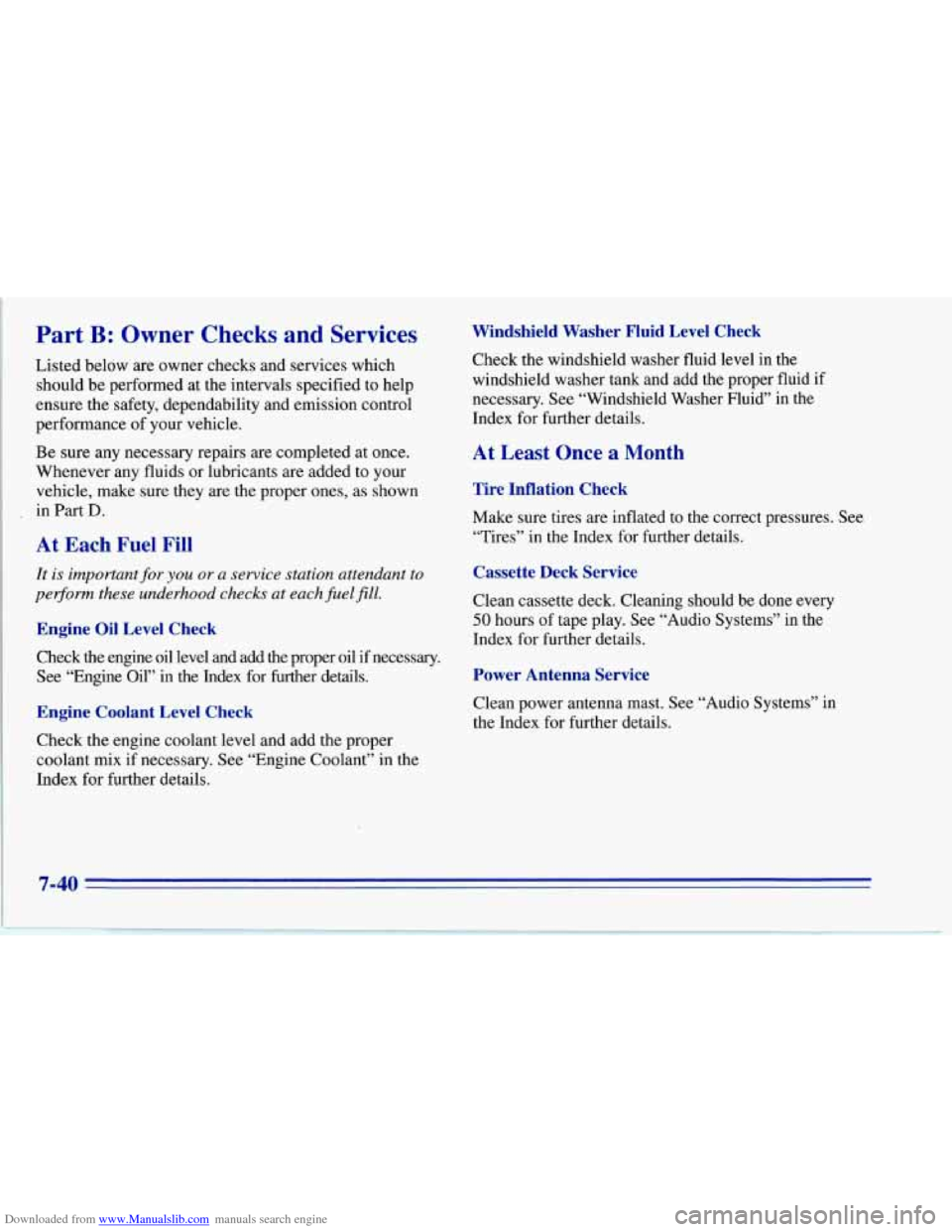
Downloaded from www.Manualslib.com manuals search engine Part B: Owner Checks and Services
Listed below are owner checks and services which
should be performed at the intervals specified to help
ensure the safety, dependability and emission control
performance of your vehicle.
Be sure any necessary repairs are completed at once.
Whenever any fluids
or lubricants are added to your
vehicle, make sure they are the proper ones, as shown
in Part
D.
At Each Fuel Fill
It is important for you or a service station attendant to
pegorm these underhood checks at each fuel
fill.
Engine Oil Level Check
Check the engine oil level and add the proper oil if necessary.
See “Engine Oil” in the Index for further details.
Engine Coolant Level Check
Check the engine coolant level and add the proper
coolant mix if necessary. See “Engine Coolant” in the
Index for further details.
Windshield Washer Fluid Level Check
Check the windshield washer fluid level in the
windshield washer tank and add the proper fluid if
necessary. See “Windshield Washer Fluid” in the
Index for further details.
At Least Once a Month
Tire Inflation Check
Make sure tires are inflated to the correct pressures. See
“Tires” in the Index for further details.
Cassette Deck Service
Clean cassette deck. Cleaning should be done every
50 hours of tape play. See “Audio Systems” in the
Index for further details.
Power Antenna Service
Clean power antenna mast. See “Audio Systems” in
the Index for further details.
7-40
Page 377 of 386
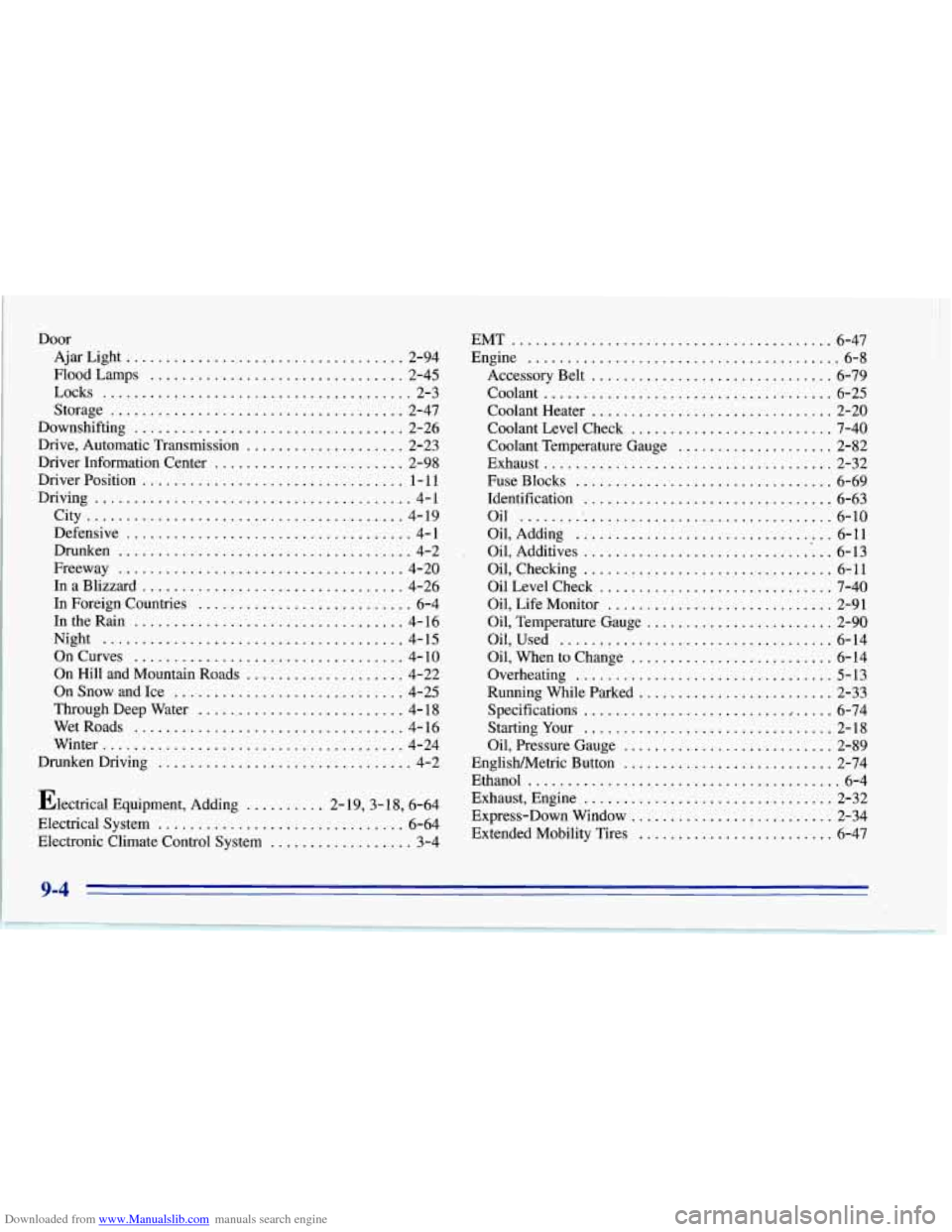
Downloaded from www.Manualslib.com manuals search engine Door AjarLight
................................... 2-94
Flood Lamps
................................ 2-45
Downshifting
.................................. 2-26
Drive, Automatic Transmission
.................... 2-23
Driver Information Center
........................ 2-98
DriverPosition
................................. 1-11
Driving
........................................ 4-1
Defensive
.................................... 4-1
Drunken ..................................... 4-2
Freeway
.................................... 4-20
InaBlizzard
................................. 4-26
In Foreign Countries ......................... . 6-4
IntheRain
.................................. 4-16
Night
...................................... 4-15
On Curves ................................... 4- 10
On Hill and Mountain Roads
.................... 4-22
On Snow and Ice
............................. 4-25
Through Deep Water
.......................... 4- 18
WetRoads
.................................. 4-16
Winter
...................................... 4-24
Drunken Driving
................................ 4-2
Locks
....................................... 2-3
Storage
..................................... 2-47
City
........................................ 4-19
Electrical Equipment, Adding
.......... 2-19,3-18, 6-64
Electrical System
............................... 6-64
Electronic Climate Control System
.................. 3-4 EMT
......................................... 6-47
Engine
........................................ 6-8
Accessory Belt
............................... 6-79
Coolant
..................................... 6-25
Coolant Heater
............................... 2-20
Coolant Level Check
.......................... 7-40
Coolant Temperature Gauge
.................... 2-82
Exhaust
..................................... 2-32
FuseBlocks
................................. 6-69
Identification
................................ 6-63
Oil
......................................... 6-10
Oil, Adding
................................. 6-11
Oil, Additives
................................ 6-13
OilLevelCheck
.............................. 7-40
Oil. Checking
................................ 6-11
Oil, Life Monitor
............................. 2-91
Oil, Temperature Gauge
........................ 2-90
Oil, Used
................................... 6-14
Oil, When to Change
.......................... 6-14
Running While Parked
......................... 2-33
Specifications
................................. 6-74
Oil, Pressure Gauge
........................... 2-89
EnglishMetric Button
........................... 2-74
Ethanol
........................................ 6-4
Exhaust, Engine
................................ 2-32
Express-Down Window
............... .......... 2-34
Overheating
................................. 5-13
StartingYour ................................ 2-18
Extended Mobility Tires
......................... 6-47